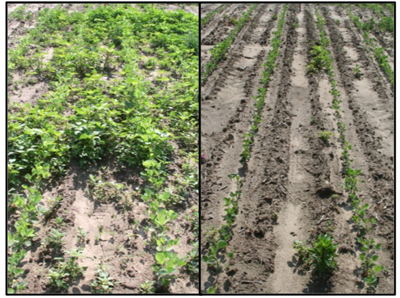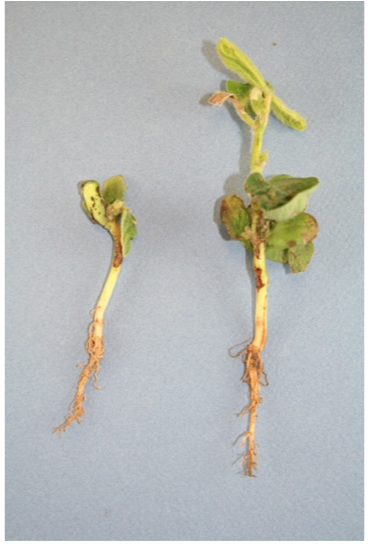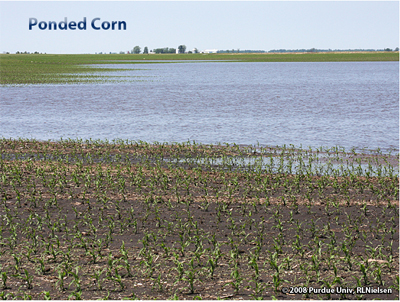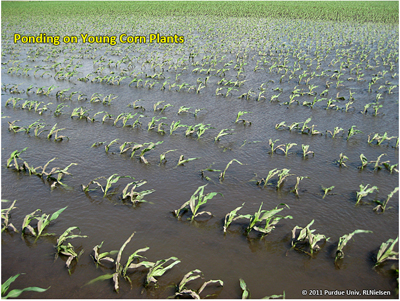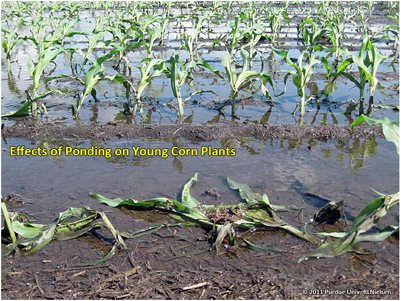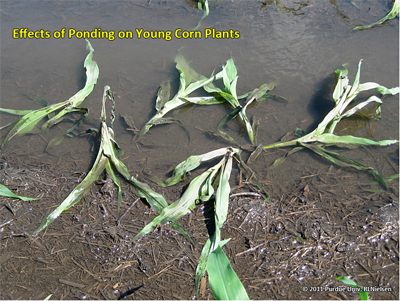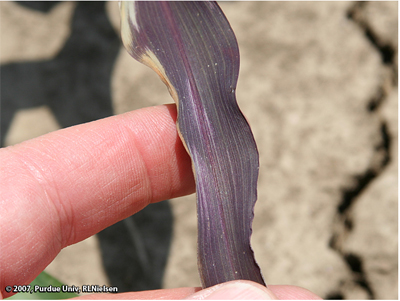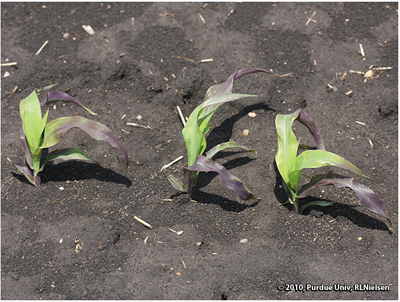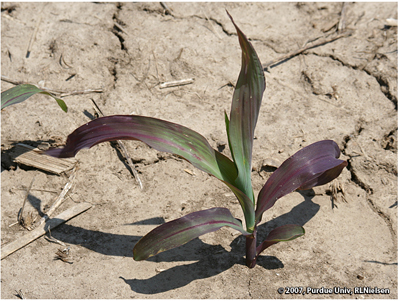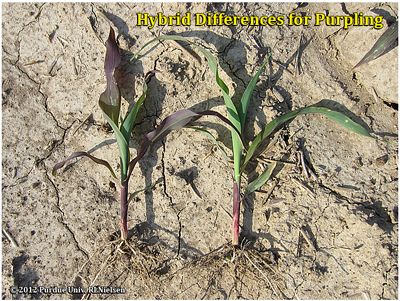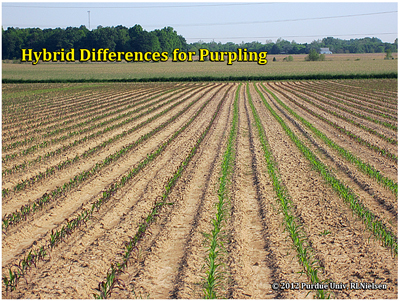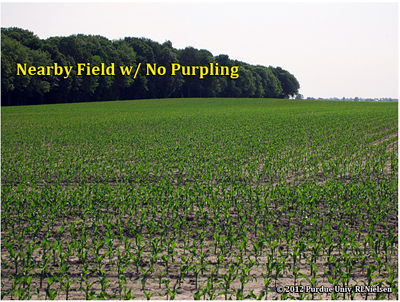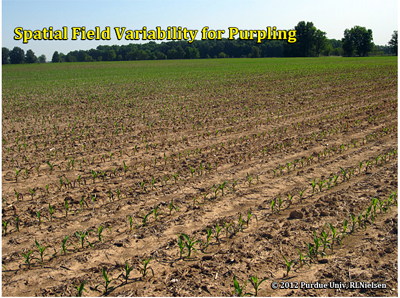USDA-NIFA Extension IPM Grant
Pest & Crop Newsletter, Entomology Extension, Purdue University
Click here to see the Black Light Trap Catch Report
![]()
VIDEO: Corn Leaf Spots, Disease or Drift - (Kiersten Wise and Travis Legleiter) -
This video shot in west central Indiana illustrates some points made in last week’s Pest&Crop’s (Issue #10, 2013) article, “Distinguishing Spots on Corn: Holocus Leaf Spot vs. Gramoxone Drift.” Because of of the similarity of symptoms on corn leaves, we take you through the diagnostic process in this video to better pinpoint the cause for necrotic spots, either a bacterial disease or drift from a burndown herbicide. The good news is that minor leaf spotting from either cause will not worsen and is of little concern to the corn field’s yield potential. We certainly want to dispel community rumors and unnecessary finger pointing...let’s keep it neighborly!
![]()
Stunted, Burned, and Crinkled Soybean Plants – (Travis Legleiter and Bill Johnson) -
Purdue Weed Scientist’s have been pushing the message of using pre-emerge herbicides in soybean over the last couple of years, especially in fields with problem weeds such as marestail, common waterhemp, and Palmer amaranth. We have promoted the use of herbicides containing flumioxazin and sulfentrazone for their residual activity on these problem weeds as well as saflufenacil products that can aid significantly when added to glyphosate burndowns. All of these herbicides are PPO-inhibiting herbicides that have residual activity in the soil and unfortunately pose some crop injury risk under certain weather conditions.
Apparently we are starting to get the message of using pre-emergence herbicides across to producers. Although, the way we know this is the number of calls, reports, and samples we have received with stunted, crinkled, and necrotic soybeans that were injury by the PPO-inhibiting pre-emerge herbicides flumioxazin, sulfentrazone, and saflufenacil.
This class of herbicides creates oxygen radicles at toxic levels that destroy the lipids of cell membranes and creates the necrotic spotting and burning that most of us recognize as leaf burning and blazing. These herbicides can be applied to soybean plants because of their ability to rapidly metabolize the herbicide and reduce the levels of toxic radicles. Under stressful growing conditions soybean plants are unable to metabolize these herbicides as quickly leading injurious levels of oxygen radicles. Soybean plants can also sustain injury due to exposure to high levels of these PPO-inhibiting herbicides.
The wet soil conditions and frequent rain events of this planting season have been ideal for soybean injury by soil applied PPO-inhibiting herbicides. The sustained cool wet soil condition that most soybean plants have been emerging this spring are less than ideal for rapid herbicide metabolism and thus has lead to almost certain injury to those fields receiving one of the PPO herbicides. Soybean injury was also increased due to heavy rainfall events that splashed herbicides on the soil surface onto emerging soybean hypocotyls, cotyledon, and/or leaves depending on the soybean growth stage. Injury symptoms include crinkled leaves, necrosis of the hypocotyl and cotyledons, and necrotic spotting on leaves where the herbicide has been splashed during a rainfall event.
Typically the risk of injury is higher in sandy and coarse soils, although this year it seems as if all soils have been susceptible due to the cool, wet weather conditions.
In the majority of cases soybean plants are able to grow out of the initial injury and yield losses do not occur. Only in rare cases of severe injury to the hypocotyl and/or growing point will replanting be required. If you suspect injury from flumioxazin, sulfentrazone, or saflufenacil on soybean you can send a sample to Purdue Plant and Pest Diagnostic lab <http://www.ppdl.purdue.edu/PPDL/> for further confirmation.
The increased amount of injury to soybean this year may cause some of our producers to avoid these particular herbicides in the future. We have seen exceptional weed control out of these PPO-inhibiting herbicides at our Palmer amaranth research site this season, especially with flumioxazin which seems to be causing the majority of soybean injury in the state. So producers need to weigh this risk of temporary injury against quality control of problematic weeds such as Palmer amaranth, common waterhemp, and marestail. In the majority of years these products pose little threat of soybean injury and sustain their level of weed control.
Image 1. The left is a photo of a plot not receiving a pre-emerge herbicide and on the right a plot receiving a pre-emerge application containing flumioxazin. Notice the injury of soybeans by the flumioxazin as well as the reduced population of Palmer amaranth that will be much more manageable as compared to the untreated plot.
Image 2. Soybean seedlings exhibiting injury from flumioxazin due to slowed metabolism and herbicide splash on the hypocotyl, cotyledons, and unifoliate leaves.
![]()
Effects of Flooding or Ponding on Young Corn – (Bob Nielsen)
Recent intense rainfall events (technically referred to as “toad stranglers” or “goose drownders”) have caused flooding of low-lying corn fields or ponding (standing water) in poorly drained swales within fields. Other areas within fields, while not technically flooded or ponded, may remain saturated for lengthy periods of time.
What are the prospects for recently submerged corn fields or plants simply enduring days and days of saturated soils? The flippant answer is that such suffering crops will survive until they die.
What I mean to say is that no one can tell you with certainty the day after the storm whether a ponded area of a corn field will survive or whether there will be long-term yield consequences until enough time has gone by such that you can assess the actual recovery of the damaged plants. We can, however, talk about the factors that increase or decrease the risks of severe damage or death to flooded soils.
• Plants that are completely submerged are at higher risk than those that are partially submerged.
°Plants that are only partially submerged may continue to photosynthesize, albeit at limited rates.
•The longer an area remains ponded, the higher the risk of plant death.
°Most agronomists believe that young corn can survive up to about 4 days of outright ponding if temperatures are relatively cool (mid-60’s°F or cooler); fewer days if temperatures are warm (mid-70’s°F or warmer).
*Soil oxygen is depleted within about 48 hours of soil saturation. Without oxygen, the plants cannot perform critical life sustaining functions; e.g., nutrient and water uptake is impaired and root growth is inhibited (Wiebold, 2013).
•Even if surface water subsides quickly, the likelihood of dense surface crusts forming as the soil dries increases the risk of emergence failure for recently planted crops.
°Be prepared with a rotary hoe to break up the crust and aid emergence.
•The greater the deposition of mud or old crop residues on plants as the water subsides, the greater the stress on the plants due to reduced photosynthesis.
°Ironically, such situations would benefit from another rainfall event to wash the mud deposits from the leaves.
•Corn younger than about V6 (six fully exposed leaf collars) is more susceptible to ponding damage than is corn older than V6.
°This is partly because young plants are more easily submerged than older taller plants and partly because the corn plant’s growing point remains below ground until about V6. The health of the growing point can be assessed initially by splitting stalks and visually examining the lower portion of the stem (Nielsen, 2008a). Within 3 to 5 days after water drains from the ponded area, look for the appearance of fresh leaves from the whorls of the plants.
• Extended periods of saturated soils AFTER the surface water subsides will take their toll on the overall vigor of the crop.
°Some root death will occur and new root growth will be stunted until the soil dries to acceptable moisture contents. As a result, plants may be subject to greater injury during a subsequently dry summer due to their restricted root systems.
°Nutrients like nitrogen are rapidly remobilized from lower leaves to upper, newer leaves; resulting in a rapid development of orange or yellow lower leaves.
°Because root function in saturated soils deteriorates, less photosynthate is utilized by the root system and more accumulates in the upper plant parts. The higher concentration of photosynthate in the stems and leaves often results in dramatic purpling of those above-ground plant parts (Nielsen, 2012).
• Concomitant (I found a new word in the dictionary!) with the direct stress of saturated soils on a corn crop, flooding and ponding can cause significant losses of soil nitrogen due to denitrification and leaching of nitrate N.
°Significant loss of soil N will cause nitrogen deficiencies and possible additional yield loss.
°On the other hand, if the corn dies in the ponded areas it probably does not matter how much nitrogen you’ve lost.
• Lengthy periods of wet soil conditions favor the development of seedling blight diseases, especially those caused by Pythium fungi (Sweets, 2012).
° Poorly drained areas of fields are most at risk for the development of these diseases and so will also be risky for potential replant operations.
• Certain diseases, such as common smut and crazy top, may also become greater risks due to flooding and cool temperatures (Pataky and Snetselaar, 2006; Sweets, 2011).
° The fungus that causes crazy top depends on saturated soil conditions to infect corn seedlings.
° The common smut fungal organism is ubiquitous in soils and can infect young corn plants through tissue damaged by floodwaters. There is limited hybrid resistance to either of these two diseases and predicting damage is difficult until later in the growing season.
Related References
Butzen, Steve. Flooding Impact on Crops. Pioneer Hi-Bred Int’l. Online at <http://www.pioneer.com/home/site/us/template.CONTENT/agronomy/crop-management/adverse-weather-disease/flood-damage/guid.DE1A9B1D-CAC0-4A04-B9CC-E0820B29080A>. [URL accessed June 2013].
Ciampiatte, Ignacio, Doug Jardine, and Dorivar Ruiz Diaz. 2013. Effect of standing water and saturated soils on corn growth and yield. eUpdate, Kansas State Univ. [On-line] Available at <http://www.agronomy.ksu.edu/doc4312.ashx>. [URL accessed June 2013].
Elmore, Roger and Lori Abendroth. 2008. Flooded Corn and Saturated Soils. Integrated Crop Management Newsletter, Iowa State Univ Extension. Online at <http://www.extension.iastate.edu/CropNews/2008/0530RogerElmoreLori+Abendroth.htm>. [URL accessed June 2013].
Farnham, Dale. 1999. Corn survival in wet conditions. Iowa State Univ. Integrated Crop Management Newsletter. [On-line] Available at <http://www.ent.iastate.edu/ipm/icm/1999/5-24-1999/wetcorn.html>. [URL accessed June 2013].
Hager, Aaron. 2011. Replanting Corn: How to Control Plants from the Initial Planting. the Bulletin, Univ. of Illinois Extension. Online at <http://bulletin.ipm.illinois.edu/article.php?id=1480>. [URL accessed June 2013].
Nielsen, RL (Bob). 2008a. Growing Points of Interest. Corny News Network, Purdue Univ. Online at <http://www.kingcorn.org/news/timeless/GrowingPoints.html>. [URL accessed June 2013].
Nielsen, RL (Bob). 2008b. Tips for Staging Corn with Severe Leaf Damage. Corny News Network, Purdue Univ. Online at <http://www.kingcorn.org/news/timeless/VStagingTips.html>. [URL accessed June 2013].
Nielsen, RL (Bob). 2008c. Use Thermal Time to Predict Leaf Stage Development in Corn. Corny News Network, Purdue Univ. Online at <http://www.kingcorn.org/news/timeless/VStagePrediction.html>. [URL accessed June 2013].
Nielsen, RL (Bob). 2010. Determining Corn Leaf Stages. Corny News Network, Purdue Univ. Online at <http://www.kingcorn.org/news/timeless/VStageMethods.html>. [URL accessed June 2013].
Nielsen, RL (Bob). 2012. Prevalent Purple Plants Perennially Puzzle Producers. Corny News Network, Purdue Extension. Online at <http://www.kingcorn.org/news/timeless/PurpleCorn.html>. [URL accessed June 2013].
Owen, Mike. 2008a. Replant Options in Corn Fields. Integrated Crop Management Newsletter, Iowa State Univ Extension. Online at <http://www.extension.iastate.edu/CropNews/2008/0531MikeOwen2.htm>. [URL accessed June 2013].
Owen, Mike. 2008b. Replanting Corn – How Do You Get Rid of the Existing Stand? Integrated Crop Management Newsletter, Iowa State Univ Extension. Online at <http://www.extension.iastate.edu/CropNews/2008/0531MikeOwen.htm>. [URL accessed June 2013].
Pataky, J. K., and K. M. Snetselaar. 2006. Common smut of corn. The Plant Health Instructor. DOI:10.1094/PHI-I-2006-0927-01 [On-line] Available at <http://www.apsnet.org/edcenter/intropp/lessons/fungi/Basidiomycetes/Pages/CornSmut.aspx>. [URL accessed June 2013].
Sweets, Laura. 2012. Seed Decay and Seedling Blights of Corn. Integrated Pest & Crop Management Newsletter, Univ of Missouri Extension. Online at <http://ipm.missouri.edu/IPCM/2012/5/Seed-Decay-and-Seedling-Blights-of-Corn>. [URL accessed June 2013].
Sweets, Laura. 2011. Crazy Top of Corn. Integrated Pest & Crop Management Newsletter, Univ of Missouri Extension. Online at <http://ipm.missouri.edu/IPCM/2011/5/Crazy-Top-of-Corn/>. [URL accessed June 2013].
Thomison, Peter. 2010. Injury to Corn from Ponding and Saturated Soils. C.O.R.N. Newsletter, Ohio State Extension. Online at <http://corn.osu.edu/newsletters/2010/2010-11/injury-to-corn-from-ponding-and-saturated-soils/?searchterm=ponding>. [URL accessed June 2013].
Wiebold, Bill. 2013. Heavy Rains Exclude Oxygen Needed for Seedling Health from Soils. Integrated Pest & Crop Mgmt, Univ of Missouri. Online at <http://ipm.missouri.edu/IPCM/2013/5/Heavy-Rains-Exclude-Oxygen-Needed-for-Seedling-Health-from-Soils>. [URL accessed June 2013].
Prevalent Purple Plants Perennially Puzzle Producers – (Bob Nielsen) -
Like the swallows that return every year to San Juan Capistrano, it seems that purpling in young corn returns every year somewhere in Indiana. In recent days, I have received several reports of purpling from widely scattered areas of the state. While mildly attractive from an ornamental standpoint, landlords and tenants alike often become concerned when they see their fields take on a purplish hue that is clearly evident from the window of the pickup at 60 mph.
Biochemical Cause of Purpling. Purpling of corn plant tissue results from the formation of reddish-purple anthocyanin pigments that occur in the form of water-soluble cyanidin glucosides or pelargonidin glucosides (Kim, 1998). A hybrid’s genetic makeup greatly determines whether corn plants are able to produce anthocyanin. A hybrid may have none, one, or many genes that can trigger production of anthocyanin. That is the reason why purpling may appear in only one of two hybrids planted in the same field. Purpling can also appear in the silks, anthers and even coleoptile tips of a corn plant.
Agronomic Cause of Purpling. Well, you may say, that’s fine but what triggers the production of the anthocyanin pigments in young corn at this time of year? The answer is not clearly understood, but most agree that these pigments develop in young plants in direct response to a number of stresses that limit the plants’ ability to fully utilize the photosynthates produced during the day.
It has been my experience that the most common contributor to the development of purple corn plants is the combination of bright, sunny days and cool nights (40’s to 50’s F) when corn plants are in the V3 to V6 stages of development (3- to 6-leaf collar stages). This combination translates to a lot of photosynthate produced during the day, but low rates of photosynthate metabolism during the night, that results in high concentrations of sugary photosynthates in the leaves. Since the anthocyanin occurs in the form of a sugar-containing glucoside, the availability of high concentrations of sugar in the leaves (photosynthesis during bright, sunny days) encourages the pigment formation. Hybrids with more anthocyanin-producing genes will purple more greatly than those with fewer “purpling” genes. In most cases, the purpling will slowly disappear as temperatures warm and the plants transition into the rapid growth phase (post-V6).
Other stresses that can restrict photosynthate metabolism in young corn plants include several that result in restricted root growth, including herbicide injury, severe phosphorus deficiency, soil compaction caused by tillage or planter traffic, excessively wet soils, excessively dry soils, insect injury, and disease injury. The negative effects of such root stresses on photosynthate metabolism can amplify the intensity of the purpling already triggered by a combination of cool nights and bright, sunny days.
What About Yield Losses? Does the leaf purpling lead to yield losses later on? It is important to recognize that the cause of leaf purpling, not the purpling itself, will determine whether yield loss will occurs.
If the main cause is simply the combination of bright, sunny days and cool nights, then the purpling will disappear as the plants develop further, with no effects on yield. If the major contributor to the purpling is restricted root systems, then the potential effects on yield will depend on whether the root restriction is temporary (e.g., cool temperatures & wet soils) or more prolonged (e.g., soil compaction, herbicide injury). Plants can recover from temporary root restrictions with little to no effect on yield. If the root stress lingers longer, the purpling may continue for some time and some yield loss may result if the plants become stunted.
If the primary cause is hybrid response to the combination of cool nights and bright, sunny days, the purpling symptoms will be spatially uniform throughout a field. If other stress factors are also restricting root development and/or function, then the purpling symptoms may be spatially variable throughout the field and correlated to soil type, drainage characteristics, or elevation of the landscape. Spatially variable patterns of purple corn may indicate the potential for lingering, yield-limiting stresses that should be more thoroughly investigated.
Related References
Chalker-Scott, Linda. 1999. Environmental Significance of Anthocyanins in Plant Stress Responses. Photochemistry and Photobiology 70(1): 1–9.
Christie, P.J., Alfenito, M.R., and Walbot, V. (1994). lmpact of low- temperature stress on general phenylpropanoid and anthocyanin pathways: Enhancement of transcript abundance and anthocyanin pigmentation in maize seedlings. Planta 194: 541-549.
Dixon, Richard A. and Nancy L. Paiva. 1995. Stress-lnduced Phenylpropanoid Metabolism. The Plant Cell 7:1085-1097. American Society of Plant Physiologists. [On-Line]. Available at <http://www.plantcell.org/cgi/reprint/7/7/1085>. [URL accessed May 2012].
Kim, Jae Hak. 1998. Maize Anthocyanin Pathway. Pennsylvania State Univ. [On-Line]. Available at <http://scripts.cac.psu.edu/courses/plphy/plphy597_hef1/mpath.html>. [URL accessed May 2012]. Editorial note: This link is for biochemistry fans!
Nielsen, R.L. (Bob). 2009. Reddish-Purple Corn Plants Late in the Season. Corny News Network, Purdue Univ. [online]. <http://www.kingcorn.org/news/timeless/PurpleCorn2.html>. [URL accessed May 2012].
Some of the chatter down at the Cock ‘n Bull Cafe still centers on the many fields of corn that exhibited such intense purpling several weeks ago. Most of the purple color has disappeared from those fields, but in many affected fields the plants in those areas remain visibly shorter and lighter green in color than the areas that did not purple. Growers are naturally concerned and asking questions about the eventual yield effect from the purpling.
As I indicated earlier in what has become an annual article about purple corn (Nielsen, 2012), it’s not the purpling itself that you should be concerned with. The purpling is simply a “red flag” that something is going on in the field, something that is stressing root development.
If the “something” that is stressing root development or function is a minor stress and short-term in duration, then there will likely be no effect on yield potential at harvest. The classic example of such a minor stress factor is the combination of brilliant sunny days (a lot of photosynthesis) coupled with cooler than optimum nights (reduced utilization of photosynthate). This combination results in the classic, and predictable, purpling of hybrids with the purpling genetics (Nielsen, 2012) and will disappear once temperatures rise to consistently warm levels.
If the “something” that is stressing root development or function is a more serious or lengthy stress, then indeed the affected areas will likely remain stunted and will likely result in lower grain yields. Such serious stress factors include lengthy periods of saturated soils, soil compaction, planter furrow compaction, herbicide injury, nematode injury, starter fertilizer injury, and low soil pH.
So........... purpling in young corn fields is simply a “red flag” that should encourage growers to further investigate the nature of the stress(es) that is restricting root development or function. That diagnosis will help you determine whether to expect yield loss in areas of fields that turn purple early in the season.
Also, please recognize that hybrids without the purpling genetics (Nielsen, 2012) are usually just as easily affected by the stress factors that limit root development or function. The difference is that those hybrids do not (cannot) turn purple and so the initial effects of the root stress are not as evident from the road.
Related Reading
Nielsen, RL (Bob). 2012. Prevalent Purple Plants Perennially Puzzle Producers. Corny News Network, Purdue Extension. [online]
![]()

